The use of the Viewer application is associated with the Results tab on the Analysis component. There are two ways of launching Viewer to access PipeLay files. Firstly, it is automatically launched when you click on many of the buttons on the Results tab, for example Open Tabular Data and Open Detailed Output. Secondly, it is likewise automatically launched if you double-click on many of the output files produced by PipeLay, for example after having clicked on Open Results Directory on the Results tab.
When you run a PipeLay analysis, all of the program input and output files have the same name or root, namely analysis. The table below lists the names of the PipeLay files with this name that you can access with Viewer.
PipeLay Input and Output File Names
analysis.pas |
Analysis specification file. Input to the analysis engine. |
analysis.out |
Analysis output file. |
analysis.prp |
Analysis report file. |
analysis.tab |
Tabular output file. |
analysis.rrp |
RAO report file. |
analysis.psr |
Summary report file. |
The Viewer application main window is shown below.

Viewer Main Window
The Viewer options and capabilities for editing, searching and printing are similar to those offered by all Windows™ editors. The menu bar and a toolbar at the top of the window are described in the next section, ‘Menus and Toolbar’. When you position the cursor over a menu command or a toolbar button, a brief description of its function is displayed on the left side of the status bar at the bottom of the window.
There are six menus on the Viewer application menu bar: File, Edit, View, Insert, Format and Help. There is a toolbar immediately below the menu bar, with buttons corresponding to the most frequently used menu commands. The menus and the toolbar are now briefly described.
The File menu, shown below, has standard Windows™ file handling commands for creating, opening and saving files.
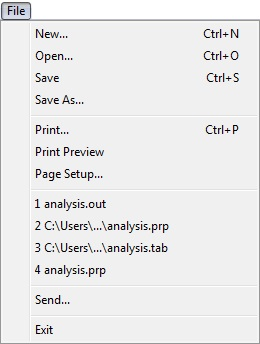
File Menu
The Edit menu, shown below, has standard Windows™ file editing commands.
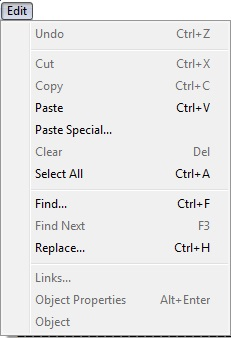
Edit Menu
The Undo command will undo the last operation performed on the currently-opened file. The Cut command removes the selected text or graph from the file for copying into the Microsoft Windows™ Clipboard. The Copy command performs the same operation but in this same the highlighted section is not removed from the current file. The Paste command is used to paste material from the Microsoft Windows™ Clipboard into the report file. The Paste Special option offers additional control over the format of the material for inclusion in the report file. The Find, Find Next and Replace options are standard Windows™ options to find and/or replace sections of text from the report. The final option on the Edit menu refers to the properties of a highlighted object within the document. To display a graph as an icon select the graph and select the Edit – Object Properties option.
The View menu, shown below, has two distinct sections. The first section (the top four options) is used to define, in standard Windows™ fashion, what the top and bottom of the application window looks like. By default, there is a toolbar at the top and a status bar at the bottom, but you can change this using the View menu, where. Options may be toggled on and off.
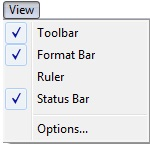
View Menu
The second section of the View menu has a number of tabs to modify the appearance of the currently-opened file. The first of these defines the measurement units to be used in the Ruler optionally displayed at the top of the file (there is no Ruler by default).
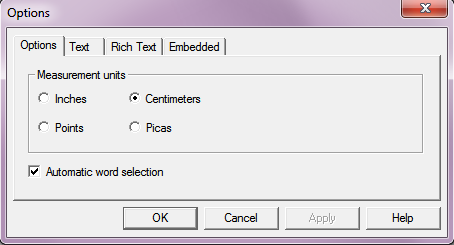
Options Tab
The next tab, Text, allows you to set defaults for use when viewing plain text files (such as verification or output files). It offers a number of options under the heading of Word wrap, relating to the wrapping of text. Selecting No Wrap signifies that the section headings are indented to the left of the margin. Selecting Wrap to Window centres the section heading to the centre of the open window. Selecting Wrap to Ruler centres the section heading to the centre of the ruler.
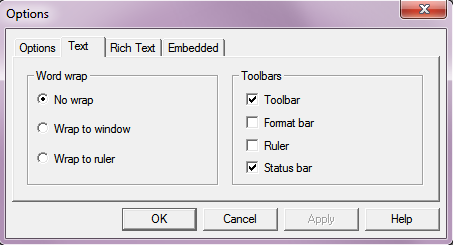
Text Tab
The Toolbars section allows you to specify whether the items listed in the first section of the View menu are enabled or disabled by default when viewing text files.
The next two tabs are Rich Text and Embedded. They are almost identical to the Text tab but the options selected apply to files specified using rich text format, such as Analysis Report Files, and embedded content respectively. For embedded content, you do not have the option of disabling the status bar.
The Insert menu allows time and date settings to be added to a section of the file. Also, a number of objects or files may be added to the document.

Insert Menu
If you invoke Data and Time… to add this information to a file, you are provided with a further menu to nominate the format you want to use.
The Object… option caters for the insertion of relevant objects created from different files into the document. You can also create a new file for insertion into your document using this feature.

Insert Object Menu
Objects are also available for display as icons if you wish only to include a link to the relevant object.
The Format menu, shown below, offers a number of options to create or modify sections of text within the document.
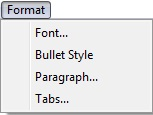
Format Menu
The Font option opens the standard Windows™ font dialog. If text is currently selected, the font style choices will be applied to the selection, otherwise they become the default style for text subsequently inserted after the current position of the cursor in the document. Bulleted text may be added to the document by selecting the Bullet Style. The alignment and width of paragraphs in the document are set under the Paragraph option. Finally the width of tab sections is set under the Tab option.
The Viewer application toolbar, which is shown below, provides you with convenient way to access the most commonly used menu commands.
Viewer Toolbar
The table below lists the function of each of the toolbar buttons. In addition, note that when you position the cursor over a toolbar button, a brief description of its function appears in the status bar at the bottom of the main window. In addition, the Viewer application supports tool tips: if you do not move the cursor, after a short time a description of the button’s function appears in a text box near the cursor.
Viewer Toolbar Options
Button |
Function |
|
New document |
|
Open document |
|
Save current document |
|
Print current document |
|
Print Preview |
|
Find |
|
Cut |
|
Copy |
|
Paste |
|
Undo |
|
Insert Date/Time |
The Viewer application supports standard Windows™ copying and printing operations. You can copy graphs and tables from the Viewer application and paste them into other applications, and you can print plots directly from the Viewer application to a printer.
To copy a graph or table from Viewer to the Microsoft Windows™ Clipboard, use either the Edit – Copy menu command or type Ctrl+C. You can then switch to another application and paste the copied graph or section or table into it. This is a convenient way of incorporating PipeLay plots and tables into presentations and reports.
To print the currently displayed report file, select the File – Print menu command or press the ![]() toolbar button. Note that you can use the File – Print Setup menu command to adjust the printer settings, and you can use the File – Print Preview command to preview the page. Both of these are standard Windows™ facilities.
toolbar button. Note that you can use the File – Print Setup menu command to adjust the printer settings, and you can use the File – Print Preview command to preview the page. Both of these are standard Windows™ facilities.